#macys culture
Explore tagged Tumblr posts
Text

Pro-Palestine demonstrators disrupt the Macy’s Thanksgiving Day Parade, Nov. 23 2023 (x) (photo by Brendan McDermid)
#Thanksgiving#Palestine#free palestine#israel#the one damn year I purposely avoid watching the parade huh#not a lot of info on this atm since it just happened a couple hours ago but keep an eye on it. don’t let folks pretend this didn’t happen.#the Macy’s Thanksgiving Day parade is a pretty widely recognized cultural event here in the US#(also generally a massive display of ‘national pride’ and capitalism/consumerism)#so the fact this happened on live TV during a major US cultural event with millions of Americans watching is something#(even though news networks seem to be doing their damndest to bury it under ‘ooo look Cher performed’
199 notes
·
View notes
Text
Gay art and culture was best when it was underground.
The gays are in popular culture now and we've sold out. Like a bunch of commercial posers over saturating the market with our narcissism, politics and bad lesbian movies.
Sad but true.
The Disney movies had gay coded songs written by lgbt people about their own struggles, psychology and being against the grain. Being different from the norm.
When you blend into the norm you lose a part of yourself.
#truth#lgbt#gay#lesbian#bi#trans#non binary#queer#gay culture#lesbian movies#art#pop culture#disney#macy's thanksgiving day parade#musicals
37 notes
·
View notes
Text

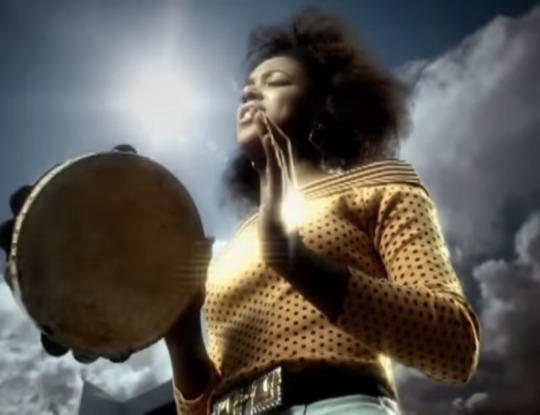
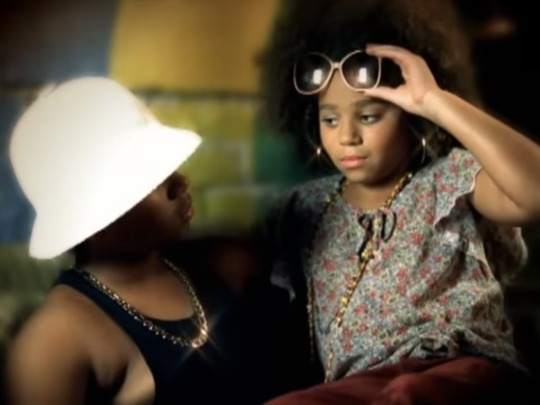




Macy Gray - Sweet Baby (2001)
Featuring Erykah Badu on backing vocals, John Frusciante on guitar and the legend Billy Preston on keys!
#music video#y2k#2000s#rnb#Macy gray#erykah badu#Billy Preston#john frusciante#sweet baby#2001#light tunnel#circle#black culture#kids#children#tambourine#ring#beach#romance#love
9 notes
·
View notes
Text
So I’m feeling really sad tonight. I have a doctors appointment tomorrow and I’ve been anxious, but really I’m just ashamed of being fat. I’ve always been fat, it’s not going to surprise my doctors, I’m the same weight I was last time.
My whole life I’ve had all this shame and guilt in me, it’s always been there. And I feel it about a lot of different things, I’ve been trying to figure out why they’re such natural state for me. There’s a mix of reasons for sure, but recently I realized that I think it comes from the original shame and guilt of being a fat kid. Of being mocked, and othered, and having my body commented on by relatives and my parents and peers. I was a kid and I was made to feel bad and inherently wrong about the way my body was. No one asked why I overate or why I was so anxious I would throw up. No one saw that, they just saw that I was fat.
When I was a preteen and even a teenager I remember laying in bed and thinking that I would take whatever amount of pain or suffering if I could just be skinny. I’d fantasize about cutting off my extra fat and feeling all of it and if the skin were just normal and smooth thereafter all the self-inflicted pain would be worth it. I used to say “by 16 I’ll be skinny, by 18 I’ll be skinny, by 25 I’ll be skinny and so on and so on. I’d walk into a room and immediately be aware of my body size and how it compared to every other person in there.
How could I not expect this to follow me? My mom was never directly mean about my weight, unless she was drunk and feeling particularly bitter. She did however help me to develop some of these negative associations around my body and food. I think I was maybe 11 the first time she told me about the “mirror diet” where you eat all your food naked in front of a mirror to basically shame yourself out of eating. I remember her hating herself and calling herself a fat cow. There was a time when she stayed in bed for 3 days straight and I swear she lost 20 pounds in a week or so; after that she kept a picture of herself in her closet so she’d “always remember what a cow she was and never go back.” She kept the weight off until she died of liver failure from years of alcoholism. Probably contributed to by the fact that she didn’t eat. She’d tell me she didn’t think she deserved food.
How could it have taken me so long to see that the guilt and shame I feel so constantly are tied to the guilt and shame that was drilled into me as a child? By my family, my peers, even my friends? I’ve said for years now that I’m okay with being fat, but isn’t all my medical anxiety really rooted in the fact that I feel like any health issues I could have would be due to my weight and is therefore my fault? How fucked up is that? I avoided the doctor for years because I was scared of being told I’m dying and that it’s my own fault for being fat and not being a better person. I’m sick of it.
I know this isn’t a very productive post, but I’ve been staring at anti-diet stuff and wondering why I feel such an ache at being told I deserve to eat and enjoy things without guilt. I do eat and enjoy things but there’s always guilt. It’s not right. I do not need to earn food, being thin does not make me a better person worthy of anymore than I have now. I’m fat, I’ve always been fat, and I will probably always be fat. That’s okay and I can live a happy and healthy life and be fat at the same time. I’m still working some of this stuff out; I just needed to get it out of my head.
#anti diet culture#fat girls#i’m okay#ed tw#food#fat#macie is dumb#also Macie is smart and beautiful and that’s just my old sorting tag that I should probably change#I’m enough#pro fat#fat liberation#I’m just working some stuff out
2 notes
·
View notes
Text






The Y2K slogan tee
#y2k core#2000s#slogan tees#fashion trends#pop culture#britney spears#avril#madonna#macy gray#anne hathaway#j lo
10 notes
·
View notes
Note
Who'd that irrelevant tiktok slut fuck to be able to "perform" at the Macy’s parade???? That is soooo low and disappointing of the company to do!!!! What is she going to do? "Dance" like a slut on a float? I feel so bad everyone involved with the float that she’ll be on…
AUTHENTIC.TALENTED.PEOPLE.ONLY.
I would dead-ass rather it be Olivia Rodrigo than her. Maybe even Billie Eilish since she had a new album come out earlier this year!
0 notes
Text
The History Of The Rickroll
If you’ve spent any time on the internet over the last number of years you’ll have no doubt come across one of the oldest and most consistent meme practices known to nerd : The Rickroll. What is it? Why is it? How is it? What Is It? Rickrolling is a prank that involves tricking someone into clicking on a link that leads to a video of Rick Astley’s 1987 hit song “Never Gonna Give You Up.” The…

View On WordPress
#4chan Rickroll origins#blog#Clickbait prank history#crazydiscostu#CRAZYDISCOSTU.COM geekery blog#Cultural impact of Rickroll#geek#Geek blog on internet culture#Internet culture legacy#Internet meme practices#Internet spam awareness#Large-scale public events pranks#Macy&039;s Thanksgiving Day Parade prank#Modern geek lifestyle blog#Nerd#Never Gonna Give You Up prank#Oldest meme on the internet#Over 400 million views legacy#Practical impact on the web#review#reviews#Rick Astley 1987 hit song#rickroll#Rickroll meme#Rickroll on YouTube#Rickroll phenomenon#Rickroll references in mainstream media#Rickrolling on Reddit and Digg#Spin-off pranks and parodies#Technologies to prevent spam
0 notes
Text
Photography: Macy's Thanksgiving Day Parade 11/23/23
Macy's Thanksgiving Day Parade @macys @RadioCity @sesamestreet @BigBird @elmo @OfficialBlueyTV @SpongeBob @Minions @Pillsbury @Pokemon @Jedi_Grogu @Dreamworks @Snoopy @smokey_bear @wimpykid @Wimpykid_Diary @EnVogueMusic @OriginalBBD @4everBrandy
Photography: Macy’s Thanksgiving Day Parade 11/23/23 Last week, I had the privilege and honor of covering this year’s Macy’s Thanksgiving Day Parade Balloon Inflation Ceremony outside of the American Natural History Museum. I walked under some of the balloons — — Ronald McDonald, Smokey Bear and Snoopy. I even snuck in a boop of Snoopy’s enormous nose. (Sorry Macy‘s, I had to. I just had to. Can…

View On WordPress
#American Natural History Museum#Arts & Culture#Baby Shark#Bell Biv Devoe#Big Bird#Bluey#Brandy#Chase#Diary of a Wimpy Kid#Elmo#En Vogue#Kung Fu Panda#Macy&039;s Thanksgiving Day Parade#Macy&039;s Thanksgiving Day Parade Balloon Inflation Ceremony#Minions#Oscar the Grouch#Paw Patrol#Photo Essay#Photography#Pikachu#Ryu#Snoopy#Spongebob Squarepants
0 notes
Text
See 4TH July Fire Works at East River , HAPPY BIRTHDAY America, See More in our World Liberty TV @
0 notes
Text
Introduction to The Mayan Popol Vuh
Introduction to The Mayan Popol Vuh
As I’ve mentioned in an earlier post or two (e.g., here and here) I’ve made a friend here in Spain who lives in a cave and makes his living playing guitar on the street. Simon is 60 years old and manages to live on the 10 Euros or so that his music affords each day. At my invitation, I spend at least an hour or so with him weekly in conversation — usually on Wednesdays. The point is to better my…

View On WordPress
1 note
·
View note
Note
Do you have a favorite scene from dragon ball or anything else akira made?
despite the fact that i've never read or watched dragon ball, it is impossible for me to not feel an immense reverence towards the passing of arguably the most significantly pivotal person in the process making anime acceptable and mainstream among general audiences.
to be clear, that guy made a story so important that all you need to do is show anyone on earth a silhouette of his protagonist's hair, and they'd likely instantly recognize it not only as a universal symbol of "Anime", but as a symbol specifically of Goku, a character culturally significant enough to show up in the Macy's Thanksgiving Parade next to Charlie Brown and Mickey Mouse (american characters made by americans being celebrated in america on an american holiday). i have the utmost respect for his legacy.
886 notes
·
View notes
Note
please predict the various stages of the “are parades gentrification?” discourse
[based on this post]
Around Thanksgiving someone points out that the Macy's Day parade (in the 1920s and 30s usa) can be analysed as part of a push against ragamuffin parades, in which children dressed as houseless beggars would go around begging for candy. The anti-begging pro-commercial sentiment that regarded department-store-sponsored parades as good, clean fun, while regarding an earlier 'folk' tradition as an annoyance and a chaotic misuse of public space (especially since it evoked begging), is part of a pattern of corporatising and 'purifying' public space in NYC.
Someone vagueblogs about how obviously completely laughable it is to claim that "parades are gentrification" (even though the original post never used this term or framing). "The Village Holiday Parade is extremely queer, guys. And it's obvious that OP is a white person who has never heard of Carnival." From here a couple side-eddies of discourse break out about the usage of the term "queer" as an "umbrella term" and whether white people can go to Carnival.
People start sending the OP of the inciting post mawkish asks about how much they love their local nowhere town's special Thanksgiving parade and is it really, really wrong to go :(
Someone makes a post like "it is so clear that none of you have ever read anything on what the term 'gentrification' means and are just going by vibes."
People agreeing with the OP point out the corporatisation of Pride. This of course leads to discourse about kink at Pride, corporation floats at Pride, PDA and "straight-passing" couples at Pride, &c. The terms "homonationalism" and "pinkwashing" get thrown around. Someone claims that the very concept of such a thing as "pinkwashing" is homophobic since it ignores the fact that gay people are oppressed or something.
Someone is like um why are we arguing about whether Thanksgiving parades are good or bad while paying no attention to colonialism. Who cares if your parade on stolen land is queer or not. This gets completely ignored.
Some people argue that different parades in different locations take place for different reasons and promote different ideologies. This breaks off into another discourse tributary about various countries' Independence Day parades and whether nationalism on the part of an oppressed group or colonised nation is good or bad.
Most people however insist upon arguing about whether all parades are good or bad and take turns listing half-remembered examples of a parade being good or bad as though they are meaningfully arguing with each other.
At some point the discourse turns to whether Carnival is an example of "cultural Christianity."
The entire time no one will define what they include in their usage of the term "parade."
579 notes
·
View notes
Text
Pink is for Boys
"Pink or Blue? Which is intended for boys and which for girls? This question comes from one of our readers this month, and the discussion may be of interest to others. There has been a great diversity of opinion on this subject, but the generally accepted rule is pink for the boy and blue for the girl. The reason is that pink, being a more decided and stronger color, is more suitable for the boy, while blue, which is more delicate and dainty, is prettier for the girl." ~ The Infants' Department, June 1918

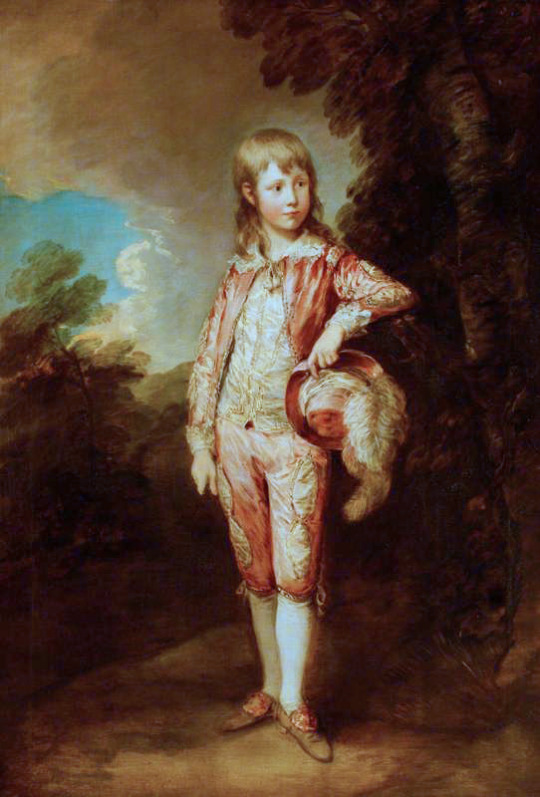
[Left: The Blue Boy, oil on canvas, c. 1770, by Thomas Gainsborough.
Right: The Pink Boy, oil on canvas, c. 1782, by Thomas Gainsborough.]
Pink is for girls and blue is for boys. But it hasn't always been this way. Colour coding infants as a way of denoting gender was popular in 20th century America. The problem? Pink and blue? Which is for boys and which is for girls?
In 1927 TIME Magazine asked ten of the "leading stores that sell baby equipment" which colour was for which gender. Four stores responded pink for girls and blue for boys; Macy's (Manhattan), Franklin Simon (Manhattan), Wanamaker's (Philadelphia) and Bullock's (Los Angeles). Five stores responded pink for boys and blue for girls; Best's (Manhattan), Marshall Field's (Chicago), Filene's (Boston), Maison Blanche (New Orleans) and The White House (San Francisco). Curiously Halle's (Cleveland) responded that pink was for both boys and girls.
This debate would continue and it wasn't until mid-20th century that pink for girls and blue for boys became firmly cemented in western culture.
However the idea of colour coding infants dates back to the 19th century. According to La cour de Hollande sous le règne de Louis Bonaparte in 1808 in Holland pink was used to announce the birth of a girl and blue a boy. In March 1856 Peterson's Magazine (Philadelphia, USA) advises that the ribbon on a christening cap should be blue for a boy and pink for a girl. On the 23rd of July 1893 the New York Times writes that for baby clothes it's "pink for a boy and blue for a girl!"

[The Oddie Children, oil on canvas, c. 1789, by William Beechey, via North Carolina Museum of Art.]
During the latter half of the 18th century one of the most popular outfits for young children, regardless of gender, was a white dress with a coloured sash tied around the waist. Pink and blue being the most popular colours, although other colours were worn as well. It would be tempting to assume that the colour of the sash indicated gender but there isn't clear evidence that this was the case. The Oddie Children (above) depicts Sarah, Henry, Catherine, and Jane Oddie. The three girls are all wearing white dresses; two with a blue sash one with a pink sash. We also see Henry Russell (bellow left) wearing a blue sash and Prince William (bellow right) wearing a pink sash.
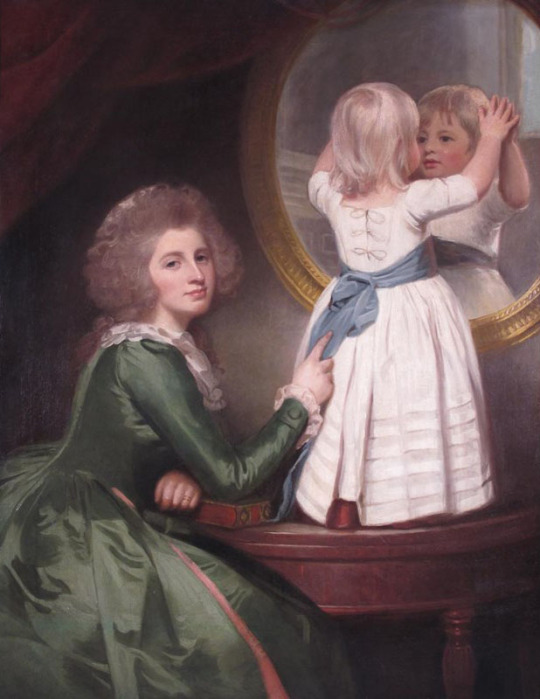
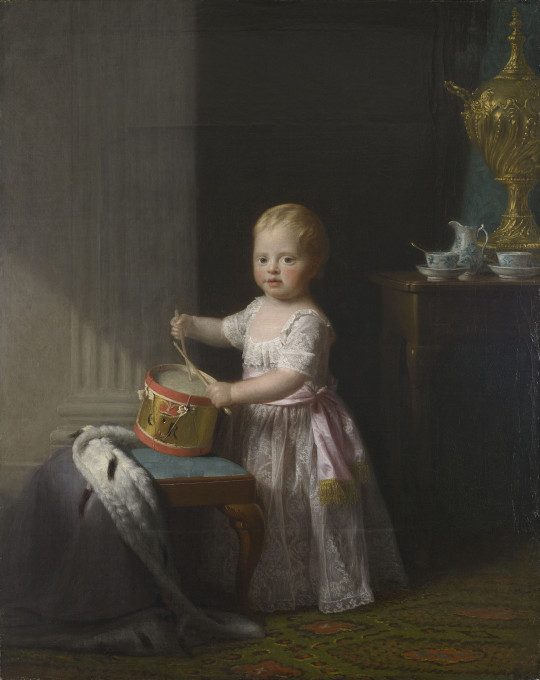
[Left: Anne Barbara Russell née Whitworth with her son Sir Henry Russell, oil on canvas, c. 1786, by George Romney, via Woolley & Wallis.
Right: Prince William, oil on canvas, c. 1767, by Allan Ramsay, via the Royal Collection Trust.]
Pink was just one of the many colours popular in 18th century English womenswear and seems to have stayed popular throughout the century. On the 3rd of January 1712 The Spectator published an article in which a man recalls seeing "a little Cluster of Women sitting together in the prettiest coloured Hoods that I ever saw. One of them was Blew, another Yellow, and another Philomot; the fourth was of a Pink Colour, and the fifth of a pale Green". On the 1st of May 1736 the Read's Weekly Journal, or British Gazetteer reports that the ladies attending the royal wedding wore gowns of "Gold stuffs, or rich Silks with Gold or Silver Flowers, or Pink or White Silks, with either Gold or Silver Netts or Trimmings;" shoes either "Pink, White or Green Silk, with Gold or Silver Lace and braid all over." On the 24th of May 1785 Charles Storer writes to Abigail Adams advising that fashionable colours in English court dress are "pink, lilac, and blue" such "as is worn at Versailles".
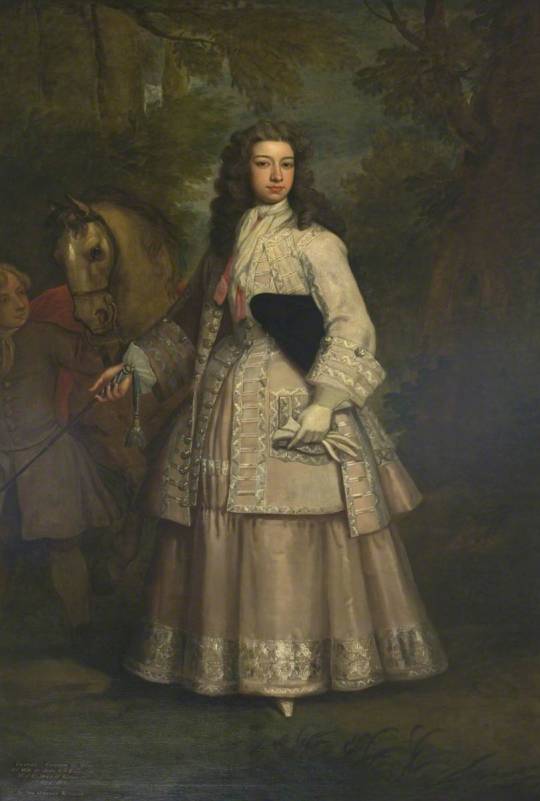
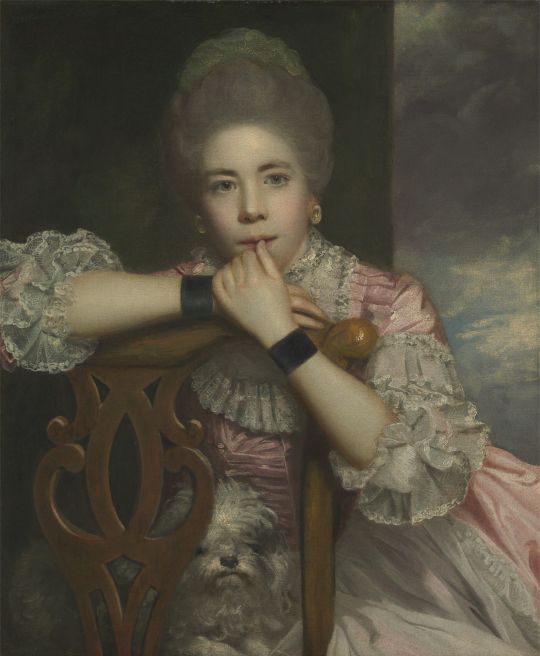

[Left: Frances, Daughter of Evelyn Pierpont, 1st Duke of Kingston, oil on canvas, c. 1700-23, by Godfrey Kneller, via Art UK.
Middle: Mrs. Abington as Miss Prue in "Love for Love" by William Congreve, oil on canvas, c. 1771, by Sir Joshua Reynolds, via Yale Center for British Art.
Right: Mary Little, later Lady Carr, oil on canvas, c. 1765, by Thomas Gainsborough, via Yale Center for British Art.]
In particular pink was popular amongst young women as the colour was associated with youth. Older women who wore pink were mocked as vain for dressing in a way that was seen as improper for their age. On the 31st of January 1754 Lady Jane Coke writes to Mrs. Eyre criticising old women who wear pink:
As for fashions in dress, which you sometimes inquire after, they are too various to describe. One thing is new, which is, there is not such a thing as a decent old woman left, everybody curls their hair, shews their neck, and wears pink, but your humble servant. People who have covered their heads for forty years now leave off their caps and think it becomes them, in short we try to out-do our patterns, the French, in every ridiculous vanity.
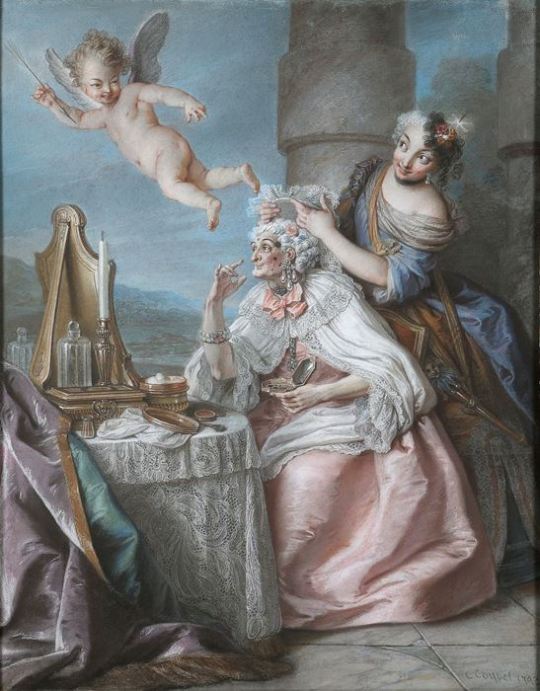
[Folly Embellishing Old Age With the Adornments of Youth, oil on canvas, c. 1743, by Charles-Antoine Coypel, via Master Art.]
For Englishmen acceptable clothing way much more limited. In A Foreign View of England in the Reigns of George I & George II Monsieur César de Saussure writes that Englishmen "do not trouble themselves about dress, but leave that to their womenfolk". He explains:
Englishmen are usually very plainly dressed, they scarcely ever wear gold on their clothes; they wear little coats called "frocks," without facings and without pleats, with a short cape above. Almost all wear small, round wigs, plain hats, and carry canes in their hands, but no swords. Their cloth and linen are of the best and finest. You will see rich merchants and gentlemen thus dressed, and sometimes even noblemen of high rank, especially in the morning, walking through the filthy and muddy streets.
César de Saussure warns that "a well-dressed person in the streets, especially if he is wearing a braided coat, a plume in his hat, or his hair tied in a bow, he will, without doubt, be called "French dog" twenty times perhaps before he reaches his destination" and is not only at risk of "being jeered at" but also "being bespattered with mud, but as likely as not dead dogs and cats will be thrown at him."

[Reverend Charles Everard Booth, Captain Griffith Booth, and an Unidentified Man playing Billiards, oil on canvas, c. 1775-9, by John Hamilton Mortimer, via the Royal Collection Trust.]
For Englishmen dressing "plainly" mostly meant wearing blacks and browns. In his book on macaroni, Pretty Gentleman, Peter McNeil found that in contrast most English menswear that he describes as generally consisting of "monochrome broadcloth" macaroni wore a variety of colours including green, orange, yellow, violet, red, white, blue, gold, silver and of course pink.
But it's not just the macaroni of the 1770s & 1780s that wore pink. We see pink in descriptions of feminine men's dress (both real and fictional) throughout the 18th century.
On the 2nd of June 1722 Sarah Osborn writes to Robert Byng:
I believe the gentlemen will wear petticoats very soon, for many of their coats were like our mantuas. Lord Essex had a silver tissue coat, and pink color lutestring waistcoat, and several had pink color and pale blue paduasoy coats, which looked prodigiously effeminate.
On the 18th of October 1729 the Universal Spectator and Weekly Journal published a story where an "effeminate" man's clothes were described as follows:
He had a flower'd pink-colour Silk Coat, with a Green-Sattin Waistcoat lac'd with Silver. Velvet Breeches, Clock'd Stockings the Colour of his Coat, Red-heel'd Pumps, a Blue Ribbon at the Collar of his Shirt, and his Sword-Hilt he embrac'd under the Elbow of his Left Arm,

[Sir Miles Stapylton, 4th Bt of Myton, oil on canvas, c. 1730-35, via Art UK.]
In The Adventures of Roderick Random (1748) the effeminate (and queer coded) Captain Whiffle is described as follows:
our new commander came on board in a ten-oared barge, overshadowed with a vast umbrella, and appeared in everything the reverse of Oakum, being a tall, thin young man, dressed in this manner: a white hat, garnished with a red feather, adorned his head, from whence his hair flowed upon his shoulders, in ringlets tied behind with a ribbon. His coat, consisting of pink-coloured silk, lined with white, by the elegance of the cut retired backward, as it were, to discover a white satin waistcoat embroidered with gold, unbuttoned at the upper part to display a brooch set with garnets, that glittered in the breast of his shirt, which was of the finest cambric, edged with right Mechlin: the knees of his crimson velvet breeches scarce descended so low as to meet his silk stockings, which rose without spot or wrinkle on his meagre legs, from shoes of blue Meroquin, studded with diamond buckles that flamed forth rivals to the sun! A steel-hilted sword, inlaid with gold, and decked with a knot of ribbon which fell down in a rich tassel, equipped his side; and an amber-headed cane hung dangling from his wrist. But the most remarkable parts of his furniture were, a mask on his face, and white gloves on his hands, which did not seem to be put on with an intention to be pulled off occasionally, but were fixed with a curious ring on the little finger of each hand.

[Henry Ingram, 7th Viscount Irwin and His Wife Anne, oil on canvas, c. 1745, by Philippe Mercier, via Art UK.]
On the 28th of July 1780 the London Courant reports:
A few days ago, a Macaroni made his appearance in the Assembly-room at Whitehaven, in the Following dress: a mixed silk coat, pink sattin waistcoat and breeches, covered with an elegant silver nett, white silk stockings with pink clocks, pink sattin shoes and large pearl buckles, a mushroom coloured stock, covered with a fine point lace; his hair dressed remarkably high, and stuck full of pearl pins.
On the 6th of August 1792 The Weekly Entertainer published Sketches and Portraits form the Life by Simon Tueopnrastus which included the following description:
Mercator was a youth of some genius and expectation, but by a strange perverseness of disposition, notwithstanding the extreme natural stiffness of his limbs, he had acquired an early attachment to the most finical and effeminate finery; so that, while yet a boy, he would exhaust every expedient of a fertile invention to procure a laced waistcoat, or the most foppish toy; would dangle a watch-string, with brass seals, from each fob, at a time when the frugal care of his parents would not permit him to wear a watch in either; and would strut in a fine pair of second-hand pink silk breeches, and a light blue coat, with all the formal dignity of—a soldier upon the parade.


[Left: Thomas King in "The Clandestine Marriage", oil on canvas, c. 1792, by Samuel De Wilde, via Yale Center for British Art.
Right: Edward Payne, oil on canvas, by Arthur Devis, via Art UK.]
While pink is mentioned in these descriptions of feminine men's dress it's not singled out as the girl colour the way pink would become in the 20th century. I would argue pink is seen as effeminate not because pink is a uniquely feminine colour but because it was used in fashionable dress. In 18th century England being interested in fashion was seen as an frivolous female trait. Men who showed too much interest in fashion were mocked and ridiculed for their gender nonconformity. "A Man must sink below the Dignity of his Nature, before he can suffer his Thoughts to be taken up on so trivial an Affair, as the Chosing, Suiting, and Adjusting the Adornments of his Person," complains a letter published on the 8th of May 1731 in Read's Weekly Journal, or British Gazetteer:
Decency of Garb ought inviolably to be preserved; nor can there be possibly an Excuse for Dressing like a Merry-Andrew: Rich and coloured Silks are in themselves effeminate, and unbecoming a Man; as are, in short, all Things that discover Dress to have been his Study 'Tis in vain for a Fop of Quality, to think his Title will protect him.


[Left: Madame de Pompadour (detail), oil on canvas, c. 1756, by François Boucher, via Alte Pinakothek.
Right: Elizabeth Wrottesley, later Duchess of Grafton, oil on canvas, c. 1764-5, by Thomas Gainsborough, via National Gallery of Victoria.]
English fashion was highly influenced by French fashion. A popular colour scheme in French fashion was green and pink. A famous example of this colour pairing can be seen in François Boucher's portrait of Madame de Pompadour (above left), she is depicted in a green gown with pink bows and flowers. You can see and example of how this style inspired English fashion in Thomas Gainsborough's portrait of Elizabeth Wrottesley (above right), who is depicted in a green gown with a floral pattern adorned with pink, white and green striped bows.
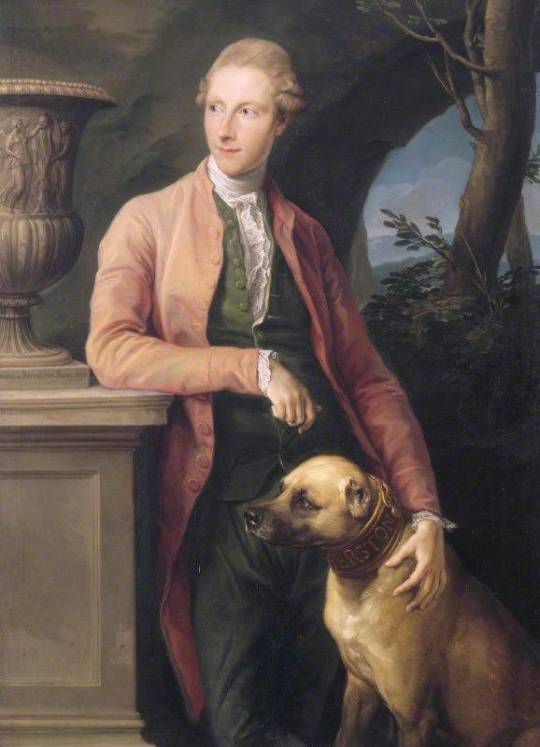
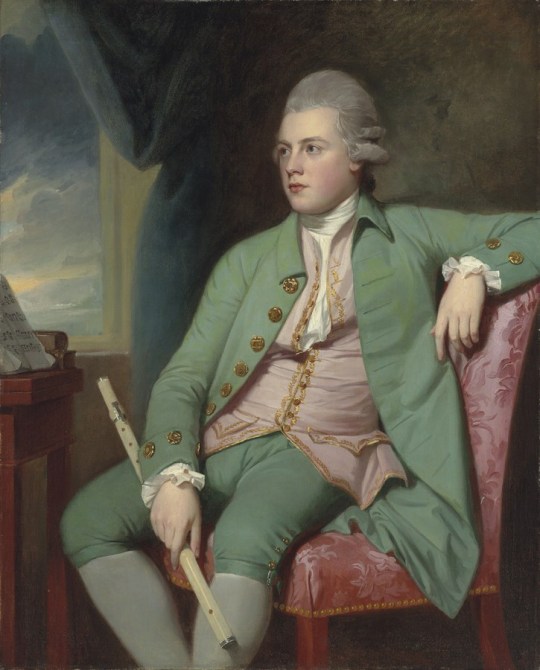
[Left: Sir Harry Fetherstonhaugh, oil on canvas, c. 1776, by Pompeo Batoni, via Wikimedia.
Right: Francis Lind, oil on canvas, c. 1775, by George Romney, via Mackinnon Fine Art.]
Fashionable Englishmen were also inspired by these French designs. Horace Walpole refers to the popularity of the colour combination writing to Lady Ossory on the 19th of February 1774 "If I went to Almack's and decked out my wrinkles in pink and green like Lord Harrington, I might still be in vogue". Almack's is referring to Almack's Assembly Rooms on Pall Mall which is believed to be the inspiration for the Macaroni Club. (see Pretty Gentleman by Petter McNeil p52-55) In a letter to Lord Harcourt on the 27th of July 1773 Walpole writes of "Macaronis lolling out of windows at Almack's like carpets to be dusted."
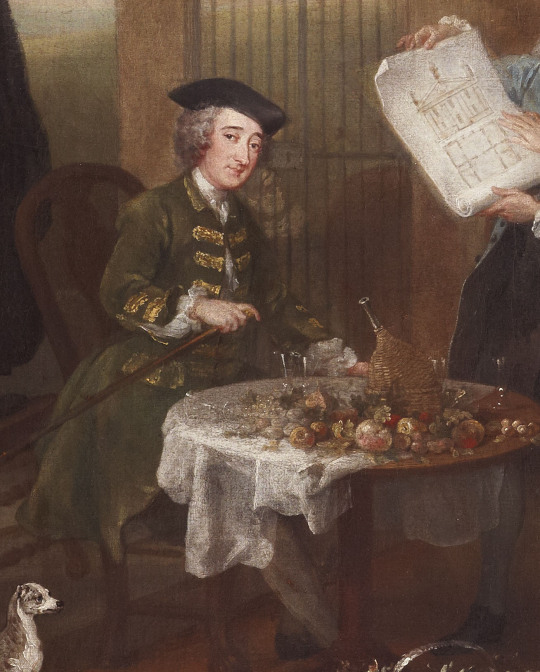

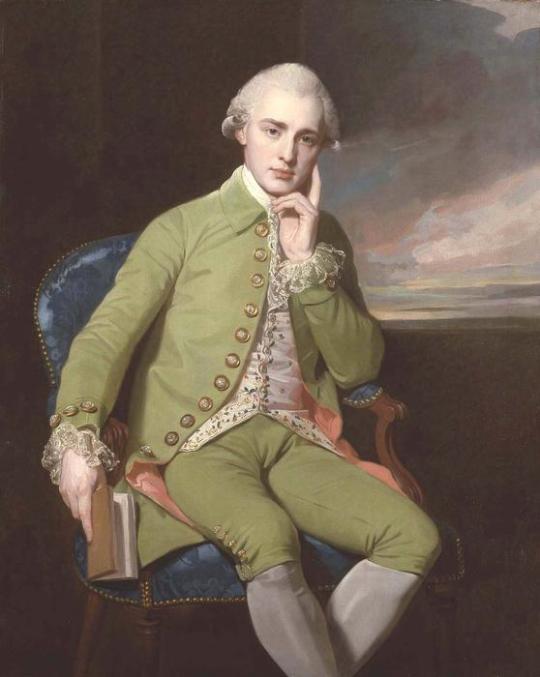
[Left: Detail of Stephen Fox from The Hervey Conversation Piece, oil on canvas, c. 1738-40, by William Hogarth, via Fairfax House.
Middle: Sir William Jones, oil on canvas, c. 1769, by Francis Cotes, via Art UK.
Right: Portrait of a Gentleman, oil on canvas, by George Romney.]
Men who wore green seem to have been just as much, if not more, at risk of being ridiculed, or even assaulted, for the colour of their clothes as those who wore pink. In Pierre Jean Grosley's A Tour to London (originally published 1772) he recalls traveling with a young English surgeon who was harassed by Londoners due to his green French frock coat:
At the first visit which he paid me in London, he informed me, that, a few days after his arrival, happening to take a walk thro' the fields on the Surry side of the Thames, dressed in a little green frock, which he had brought from Paris, he was attacked by three of those gentlemen of the mobility, who, taking him for a Frenchman, not only abused him with the foulest language, but gave him two or three slaps on the face: "Luckily, added he in French, I did not return their ill language; for, if I had, they would certainly have thrown me into the Thames, as they assured me they would, as soon as they perceived I was an Englishman, if I ever happened to come in their way again, in my Paris dress."
242 notes
·
View notes
Photo

100 Most Fascinating Facts About the Empire State Building
The Empire State Building, located in the heart of Manhattan, New York City, is an iconic skyscraper and one of the most famous landmarks in the world.
Construction of the Empire State Building began on March 17, 1930, and was completed in just 410 days, opening its doors to the public on May 1, 1931.
Standing at a staggering height of 1,454 feet (443.2 meters), including its antenna, the Empire State Building was the tallest building in the world when it was completed. It held this title for nearly 40 years until the completion of the World Trade Center's North Tower in 1970.
The Empire State Building has 102 floors, with 86 of them being used for office space, and it houses numerous businesses and organizations.
The building was designed by architect William F. Lamb, who worked for the architectural firm Shreve, Lamb & Harmon Associates. The design was inspired by the Art Deco style, which was prevalent in the 1930s.
It cost approximately $40 million to build the Empire State Building, which would be equivalent to over $700 million in today's money when adjusted for inflation.
The building's construction was completed during the Great Depression, and it was often referred to as the "Empty State Building" during its early years due to the difficulty of finding tenants for the office spaces.
To finance the construction, the Empire State Building was funded by a group of wealthy investors, including John J. Raskob, a financier and businessman.
The building's exterior is clad in Indiana limestone and granite, giving it a distinctive and elegant appearance.
The Empire State Building's famous Art Deco spire was originally intended to serve as a mooring mast for dirigibles, but the idea was quickly abandoned due to safety concerns and strong winds at such heights.
The building's construction progressed at a remarkable rate of four and a half stories per week, an unprecedented speed for that time.
During the construction, five workers tragically lost their lives, and they are honored with a memorial plaque inside the building.
The Empire State Building has a total of 73 elevators, including service elevators, and it takes just 45 seconds to reach the 86th-floor observatory from the ground floor.
The building's 86th-floor observatory offers breathtaking panoramic views of New York City and has been visited by millions of tourists from around the world.
Notable visitors to the Empire State Building include several world leaders, celebrities, and even fictional characters like King Kong in the classic 1933 film.
The Empire State Building was the location of several daredevil stunts and record-breaking feats, including the famous race to the top between a man and an elevator.
The building's official lighting system can be programmed to display various colors and patterns during different events and celebrations, making it a striking presence in the New York City skyline.
Every year, on Independence Day, the Empire State Building participates in the Macy's Fourth of July Fireworks display, illuminating the night sky with a colorful show.
In 1964, the Empire State Building was designated as a National Historic Landmark, recognizing its cultural and historical significance.
The building's observatories are open to the public year-round, and they are especially popular during the annual Empire State Building Run-Up event, where participants race up the stairs to the 86th floor.
The iconic scene from the movie "Sleepless in Seattle," where Tom Hanks and Meg Ryan meet on the observation deck, has become a quintessential romantic movie moment.
The Empire State Building has been featured in numerous movies, TV shows, and music videos, cementing its status as a symbol of New York City and an emblem of urban life.
On a clear day, visitors to the observatory can see up to five states: New York, New Jersey, Pennsylvania, Connecticut, and Massachusetts.
The building has experienced several incidents of lightning strikes, but its construction materials safely disperse the electrical charge, keeping it relatively safe during storms.
The Empire State Building's Art Deco lobby is adorned with beautiful murals and decorative elements, transporting visitors back to the glamour of the 1930s.
A famous photograph called "Lunch Atop a Skyscraper" was taken during the construction of the building, showing construction workers casually sitting on a steel beam high above the city.
The Empire State Building has appeared in various video games, becoming a recognizable virtual landmark in games set in New York City.
The building's famous spire has undergone several alterations and changes over the years, including the addition of a television broadcasting antenna.
An observation deck is located on the 102nd floor, offering an even higher vantage point for those willing to climb a few more flights of stairs.
During the annual Empire State Building Run-Up, the fastest recorded time for ascending to the 86th floor is just under 10 minutes.
The building's exterior lights are often coordinated to support important causes, such as lighting up in specific colors to raise awareness for charitable events and holidays.
The Empire State Building's lobby houses a scale model of the building, offering visitors a close-up look at its architectural features and design.
The Empire State Building's design and construction techniques were considered innovative for their time, and many of its principles have influenced the development of future skyscrapers.
The building's façade features intricate stone carvings, depicting various animals and mythological creatures, adding a touch of artistry to its exterior.
The Empire State Building was the first building to have more than 100 floors, making it a true marvel of engineering and architectural achievement.
The building's steel frame weighs around 57,000 tons, and the total weight of the building, including its contents, is estimated to be over 365,000 tons.
In 1945, a B-25 bomber crashed into the Empire State Building's 79th floor in dense fog, resulting in 14 fatalities and significant damage to the building.
The Empire State Building's architecture has served as inspiration for various skyscrapers and buildings around the world.
The building's height, including its antenna, is precisely 1,454 feet and 8 9/16 inches (443.2 meters), making it an engineering marvel to achieve such precision during the 1930s.
The Empire State Building has been featured in numerous songs, poems, and works of literature, cementing its status as a symbol of ambition, progress, and the American Dream.
The building's main lobby features a stunning ceiling mural titled "American Progress" by artist Roy Sparkia, depicting the rise of New York City.
A bronze plaque on the ground floor commemorates the visit of President Franklin D. Roosevelt, who turned on the building's lights with a push of a button on May 1, 1931.
The Empire State Building was the location of a unique event in 1951 when Kathryn Johnston became the first woman to be married on the building's observatory.
In 1980, the exterior of the Empire State Building was designated as a city landmark, ensuring its preservation for future generations.
The Empire State Building's prominence as a symbol of American industrial prowess and architectural excellence was further solidified by its inclusion in the Great Seal of New York City.
The building has been featured on several postage stamps issued by the United States Postal Service, further showcasing its iconic status.
The Empire State Building played a significant role in numerous movie plots, and its imposing presence has served as a backdrop for memorable cinematic moments.
The building's immense height allows it to be visible from various points across New York City, making it a guiding landmark for many residents and tourists.
The Empire State Building was depicted in the 1983 video game "King Kong," where players climbed the building to rescue the titular character.
The building's observation decks have hosted numerous special events, including weddings, proposals, and even a high-wire walk by daredevil Philippe Petit in 1974.
The Empire State Building is an energy-efficient building, and it has earned a Leadership in Energy and Environmental Design (LEED) Gold certification for its sustainability practices.
The annual Empire State Building Run-Up attracts participants from around the world, with many athletes and fitness enthusiasts challenging themselves to conquer the stairs.
The building's 86th-floor outdoor observatory has been featured in movies like "An Affair to Remember" and "Sleepless in Seattle" as a place where couples can share special moments and breathtaking views.
The building's observation decks have been the setting for several world records, including the highest concert and the highest-flying paper airplane launch.
On a windy day, the Empire State Building sways gently, and the topmost floors can sway up to several feet due to its flexibility and structural design.
The Empire State Building has appeared in numerous comic books and graphic novels, often serving as a backdrop for superhero battles and epic showdowns.
The building's observatories are equipped with high-powered binoculars to allow visitors to get a closer look at various landmarks and attractions across the city.
The Empire State Building has been featured in various virtual reality experiences, allowing people from around the world to explore its heights without leaving their homes.
The Empire State Building's façade lighting is often used to commemorate special occasions, such as holidays, national events, and philanthropic initiatives.
During the Christmas season, the Empire State Building is illuminated with festive colors, and a large Christmas tree is displayed in the lobby.
The building's observatories are open until midnight, offering visitors a chance to experience the stunning nighttime views of the city that never sleeps.
The Empire State Building's central location in Midtown Manhattan makes it a convenient starting point for tourists exploring the city's many attractions.
The Empire State Building has been featured in video games like "Grand Theft Auto IV" and "Crysis 2," allowing gamers to interact with a virtual representation of the iconic structure.
On a clear night, the Empire State Building's lights can be seen from miles away, creating a mesmerizing sight in the New York City skyline.
The building's annual lighting of the tower in blue on April 15th marks the start of Autism Awareness Month, showing its support for autism-related initiatives.
The Empire State Building has been depicted in countless postcards, souvenirs, and artworks, becoming an emblem of New York City's skyline.
The building's iconic mast and tower were originally intended to serve as docking points for airships, but advancements in aviation technology rendered this idea impractical.
In 1947, a United States Army Air Force B-25 Mitchell bomber successfully made a round-trip flight between New York City and Bermuda, proving the feasibility of commercial transatlantic flights.
The Empire State Building was featured in the climactic battle scene of the 2012 film "The Avengers," where the superheroes fought off an alien invasion from the top of the building.
The Empire State Building has appeared in numerous disaster movies, where it is often destroyed or damaged by earthquakes, tidal waves, and alien invasions.
The building's observatories offer a clear view of the Statue of Liberty, Ellis Island, Central Park, and other iconic New York City landmarks.
The Empire State Building's interior spaces have been used as sets for various film and TV productions, including commercials, documentaries, and music videos.
On special occasions, the Empire State Building's lights synchronize with music, creating stunning light shows visible from various vantage points around the city.
The building has served as a popular backdrop for fashion shoots, with models posing on its observation decks or in front of its grand entrance.
The Empire State Building was the tallest building in the world when it was featured in the classic 1933 film "King Kong," where the giant ape climbed to the top.
The building's annual Empire State Building Run-Up attracts participants from various backgrounds, including professional athletes, firefighters, and fitness enthusiasts.
The Empire State Building has been a popular destination for marriage proposals, with its breathtaking views providing a romantic setting for couples in love.
The building's observation decks have hosted a variety of events, including live music performances, book signings, and art exhibitions.
The Empire State Building's design incorporates setbacks, creating a distinctive and recognizable silhouette on the Manhattan skyline.
The Empire State Building has been featured in numerous post-apocalyptic movies, symbolizing the endurance of human architecture in the face of catastrophe.
The building's height makes it an ideal location for various telecommunication antennas, broadcasting radio, television, and mobile signals to the city.
The Empire State Building is lit up in blue and white in honor of the annual International Day of Peace on September 21st, promoting global harmony.
The building's interior lobby and halls have appeared in several period dramas and historical movies, evoking the elegance of the Art Deco era.
In 1994, a Norwegian base jumper successfully parachuted from the top of the building, landing safely on the streets of Manhattan.
The Empire State Building has served as a focal point in various New Year's Eve celebrations, with its lighting being an integral part of the festivities.
The Empire State Building has been used in art installations and performance pieces, exploring themes of urbanization, identity, and human experience.
The building's observation decks have been visited by numerous celebrities and dignitaries, from movie stars to political leaders from around the world.
The Empire State Building's Art Deco style has inspired interior designs, fashion trends, and architectural elements in buildings worldwide.
The Empire State Building has been depicted in animated movies and TV shows, capturing the imaginations of younger generations.
The building's grand entrance features exquisite decorative bronze doors, with intricate reliefs and ornamental details.
The Empire State Building has been featured in numerous books and documentaries that explore its history, engineering, and cultural significance.
The building has been the subject of various art projects, including paintings, sculptures, and installations, showcasing its allure as an artistic muse.
The Empire State Building has served as a symbol of resilience, representing New York City's ability to recover and rebuild after the tragic events of September 11, 2001.
The building's observatories have been visited by prominent figures in history, including Queen Elizabeth II, Princess Diana, and the astronaut Neil Armstrong.
The Empire State Building's annual Halloween lighting event sees the top of the building bathed in orange and other eerie colors, adding a spooky touch to the city's skyline.
The building's observatories have been used to conduct scientific research, such as atmospheric studies and meteorological observations.
The Empire State Building was featured in the 2005 film "King Kong," where the giant ape climbed to the top once again in a modern retelling of the classic story.
The building's exterior and observatories have been a popular filming location for various TV shows, commercials, and music videos.
The Empire State Building has been featured in the backdrop of countless wedding photographs, becoming an iconic symbol of love and commitment.
As one of the most recognizable buildings in the world, the Empire State Building continues to be a symbol of human achievement, architectural excellence, and the spirit of New York City. Its enduring appeal and timeless beauty ensure its place in history for generations to come.
#Empire State Building#New York City#new york#newyork#New-York#nyc#NY#Manhattan#urban#city#USA#United States#buildings#travel#journey#outdoors#street#architecture
685 notes
·
View notes
Note
Earthspark should do a Halloween episode. And a Thanksgiving episode. And a Christmas episode. Given that the Terrans are interested in learning a lot about Earth culture, it would be a missed opportunity if we don't actually get an episode of each holiday, and I can see some interesting plot ideas for each one. The Halloween one could have the Terrans meeting some more of the kids in Witwicky or Philadephia who are Robby and Mo's friends. The Thanksgiving episode could actually introduce more of the extended Malto family, or have a small cameo of a Transformer balloon at the not-Macy's Thanksgiving Day Parade or Optimus having to pardon a turkey. The Christmas one could explore the different celebrations at that time of year, maybe have the Terrans experience snow for the first time, or have them meet Santa Claus or whatever. Earthspark is just good for a bunch of holiday centric episodes.
I saw the words "introduce more of the extended Malto family" and my first thought was LET THE TERRANS MEET THEIR GRANDPARENTS IF THEY NOW HAVE ANY
Like
Give us the most loving grandparents that seem like they came out of a kids cartoon to the already rich in mentor / familial figures Terrans. Because I think that would be sweet and hilarious as hell.
I feel like a Halloween episode would be a rather good detective episode too ngl (that or an episode involving Tarantulas again!)
Also the Maltobots experiencing snow for the first time!
Okay the idea of Optimus getting to pardon a turkey gives me the image of him literally carrying around a turkey everywhere the entire episode, and he either gives it a goofy name or a funnily formal name.
I'd love love love to see more of Alex and Dot's life before they got involved with the transformers (at the least stuff from before the war ended), and them meeting with family and doing all the holiday stuff is a perfect opportunity
They probably wouldn't even dare do it in canon but I just got the lovely idea of someone trying their best to get Megatron and Optimus under the mistletoe
Hell I don't care if it's some generic funny in universe holiday, considering how we saw mother's day I feel like that's less likely, but it'd be still fun because it conveys what I'm focusing on myself: the sense of family and learning new things we see consistently throughout the series with the Maltos.
#maccadam#transformers#transformers earthspark#i don't even usually celebrate any holidays lol#tfe tarantulas#tfe megatron#tfe optimus prime#megop#because yes#tfe robby#tfe mo#tfe dot malto#tfe alex malto#i don't even care what holiday is chosen#just the vibes#do you know how sweet it would be to see alex and dot plan their Christmas stuff and talk about past years with fond nostalgia#SOMEONE SHOULD FACEPLANT INTO THE SNOW#also the perfect opportunity to discuss possible energon goodies#like#of all the parts of idw i think earthspark needs the most it's that. plz. hasbro. it would be so cool and sweet to give the mecha treats#ALSO HARMLESS OR SEMI-HARMLESS DECEPTICON SHENANIGANS
40 notes
·
View notes
Text
Final Predictions for Kingdom of the Planet of the Apes
I got inspired by Ape Nation's recent video. Here are my final predictions for Kingdom of the Planet of the Apes. This is in no particular order.
William H. Macy's character is NOT Mae's father, or a leader of an underground human community or both.
I watched an interview with all the cast and crew, and William H. Macy briefly talked about his character without spoiling too much. However, my final prediction is his character will be a human counterpoint of Raka, not Proximus Caesar. Someone who is a mentor/wise figurehead for Mae, but she has some reservations about him and his choices.
2. Mae is NOT an astronaut, but she MIGHT be from an underground human community.
Tbh, I would like to see the Icarus astronauts return in this (hopefully) new trilogy. However, I never bought into the "Mae being an astronaut" theory. It's still too early to introduce the astronauts, and the apes are discovering the use of human technology. We do see hints of space exploration from the trailers, like the observatory scene (and it's a cool reference to the Space Jockey from Alien).

I think Mae is from an underground human community that retained human speech and intelligence (hence the TV ads of her speaking). I think she's either sent on this mission by someone, or maybe of her own accord.
3. Mae Betrays Noa Or Vice Versa
I think Mae is going to betray Noa at some point during the movie. Whether she is forced to by Proximus Caesar, or it may be of her own accord for her mission or whatever reason. I don't think it'll be for malicious intentions, though. I think it'll be more along the lines of how teenagers tend to lie to their friends about certain things. I think she also might have some antihero tendencies, since she has to team up with Noa and Raka.
On the other hand, I do think Noa might betray Mae for similar reasons.
4. Raka Dies
Okay, I'm jumping on the current bandwagon for this one. I think Raka might die at some point in the movie, the wise elder character always does in stories like this; maybe when Noa and Mae are captured and brought to Proximus Caesar. Or maybe he's injured and needs help.
5. The Apes Will Also Learn How to Swim
Interestingly enough, most chimpanzees cannot swim due to muscle-to-fat ratio . However, there's scenes from the trailers where the chimps are getting away from the gorilla guard in that flooded bunker or ship. I think the apes will somehow learn how to swim, and maybe that will be an indication of how they’re evolving even further.
6. Noa Is Not A Descendant of Caesar
If Noa isn't a descendant of Caesar, that's okay too. I'm interested in his character, and how he will learn and grow during the movie. And reading about isolationist communities, individuals get culture shock very quickly. Noa's said to be the equivalent of a young adult/teenager, so he has a chance to learn about the outside world compared to others.
7. Soona or Anaya Gets Injured
I hate to say this, but I think either Soona or Anaya is going to get injured. Whether during the final fight scene or the flood. And from what I’ve seen of that aforementioned interview, it most likely will be Anaya who'll get injured.
8. Kingdom Will Be A Very, Very, Very Subtle Remake of Beneath
This is my crazy take, lol. Since there's scenes from the trailers and ads of Noa, Mae, Soona and Anaya in some kind of underground bunker, and what looks like a classroom.

And since Rise is technically a loose remake of Conquest. I think this movie might be a very loose remake of Beneath.
I don't think Kingdom will have the human mutants, maybe little Easter eggs here and there. This movie is using the Hero's Journey for Noa's character, and possibly for Mae as well. And from what Wes Ball has said, this movie is a stand alone story set 300 years after War.
#kingdom of the planet of the apes#planet of the apes#noa#mae#raka#soona#anaya#beneath the planet of the apes#escape from the planet of the apes#conquest of the planet of the apes#battle for the planet of the apes#rise of the planet of the apes#dawn of the planet of the apes#war for the planet of the apes#owen teague#freya allan#kevin durand#william h macy#wes ball#proximus caesar#kotpota
18 notes
·
View notes